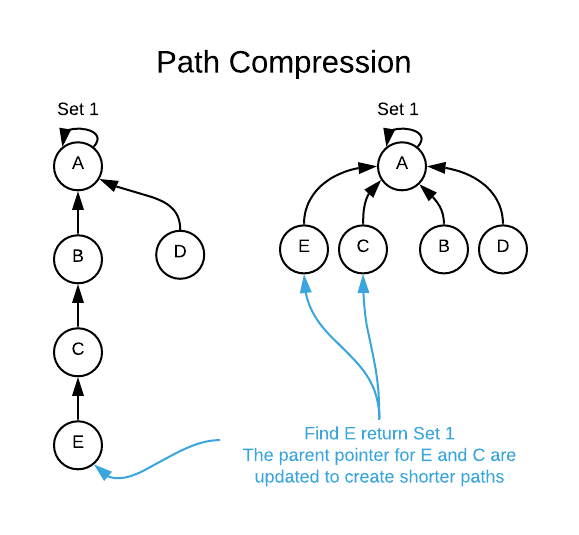Union Find
- A disjoint-set data structure is a data structure that keeps track of a set of elements partitioned into a number of disjoint (non-overlapping) subsets.
- A union-find algorithm is an algorithm that performs two useful operations on such a data structure.
- Union Find in 5 minutes — Data Structures & Algorithms - YouTube
The Two Useful Operations

- Find Operation: O(N)
- Used to find which component a particular element belongs to
- Find the root of the component by following the parent nodes until a self loop is reached(a node who's parent is itself)
- On the picture you can see [8 is paired with 8], [1 is paired with 1]
def find(x):
if Parent[x] != x: #not self-loop
return find(Parent[x])
return x
- Union Operation: O(N)
- Used to unify two elements
- Find which are the root nodes of each component and if the root nodes are different make one of the root nodes be the parent of the other.
def union(x,y):
Parent[find(y)] = find(x)
#Example check whether or not the elments x and y are in the same components
def connected(x,y):
return find(x) == find(y)
Optimizing Find Operation: Union Find Path Compression
The previous operation on worst case performs O(n) since we will need to hop n times to reach the root.


- Path compression
- The idea is to flatten the tree when find() is called.
- Path compression is to make the found root as parent of x so that we don’t have to traverse all intermediate nodes again.
- If x is root of a subtree, then path (to root) from all nodes under x also compresses.
def find(x):
root = x
while Parent[root] != root:
root = Parent[root]
while x != root:
Parent[x], x = root, Parent[x]
return root
# or with recusion
def find(x):
if self.par[x] != x:
self.par[x] = self.find(self.par[x])
return self.par[x]
Optimizing Union Operation: Union by Rank
- Union by rank optimizes the union operation in Union-Find.
- It ensures the tree with fewer nodes is attached to the root of the tree with more nodes.
- This optimization aims to keep the overall height of the tree minimal.
- It improves the efficiency of both union and find operations.
- The rank of a tree serves as an upper bound on its height.
- During union, the tree with lower rank is attached to the root of the tree with higher rank.
- This prevents the tree from becoming unbalanced, maintaining performance.
- Union by rank helps reduce the worst-case time complexity of find operations to nearly constant time.
- Overall, it enhances the efficiency and effectiveness of the Union-Find data structure.

Template for Union Find
class UF:
def __init__(self, n):
self.par = {i:i for i in range(n)}
self.rank = [1] * n
def find(self, x):
if self.par[x] != x:
self.par[x] = self.find(self.par[x]) #path compression
return self.par[x]
def union(self, x, y):
px, py = self.find(x), self.find(y)
if px == py:
return
# union by rank
if self.rank[px] < self.rank[py]:
self.par[px] = py
self.rank[py] += self.rank[px]
else:
self.par[py] = px
self.rank[px] += self.rank[py]
# additional: optional functions
def connected(self, x, y):
return self.find(x) == self.find(y)
Application of Union Find
- Solved problems
- Check whether an un-directed graph contains cycle or not
- Find Number of components in set of graphs
- Find common ancestor in trees